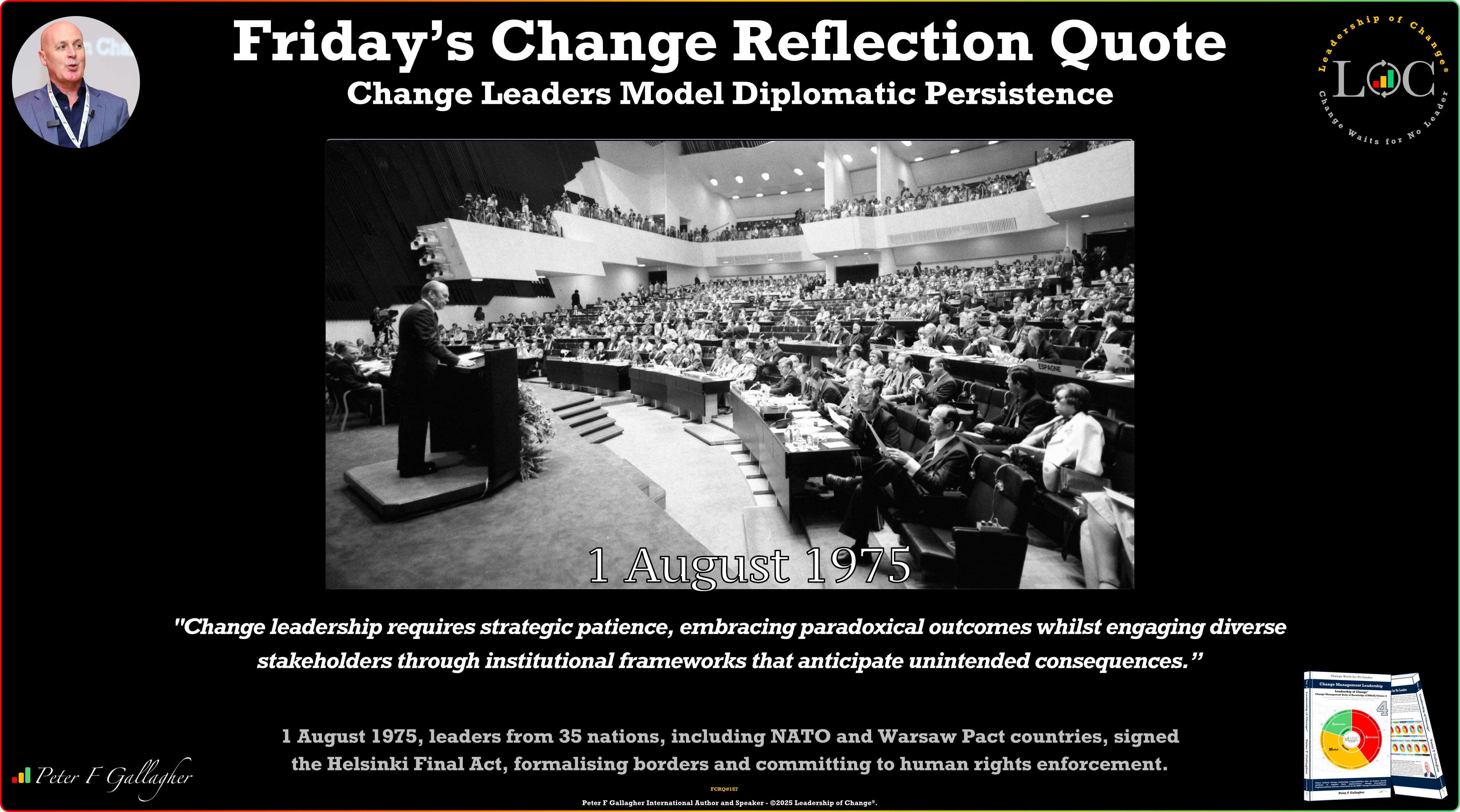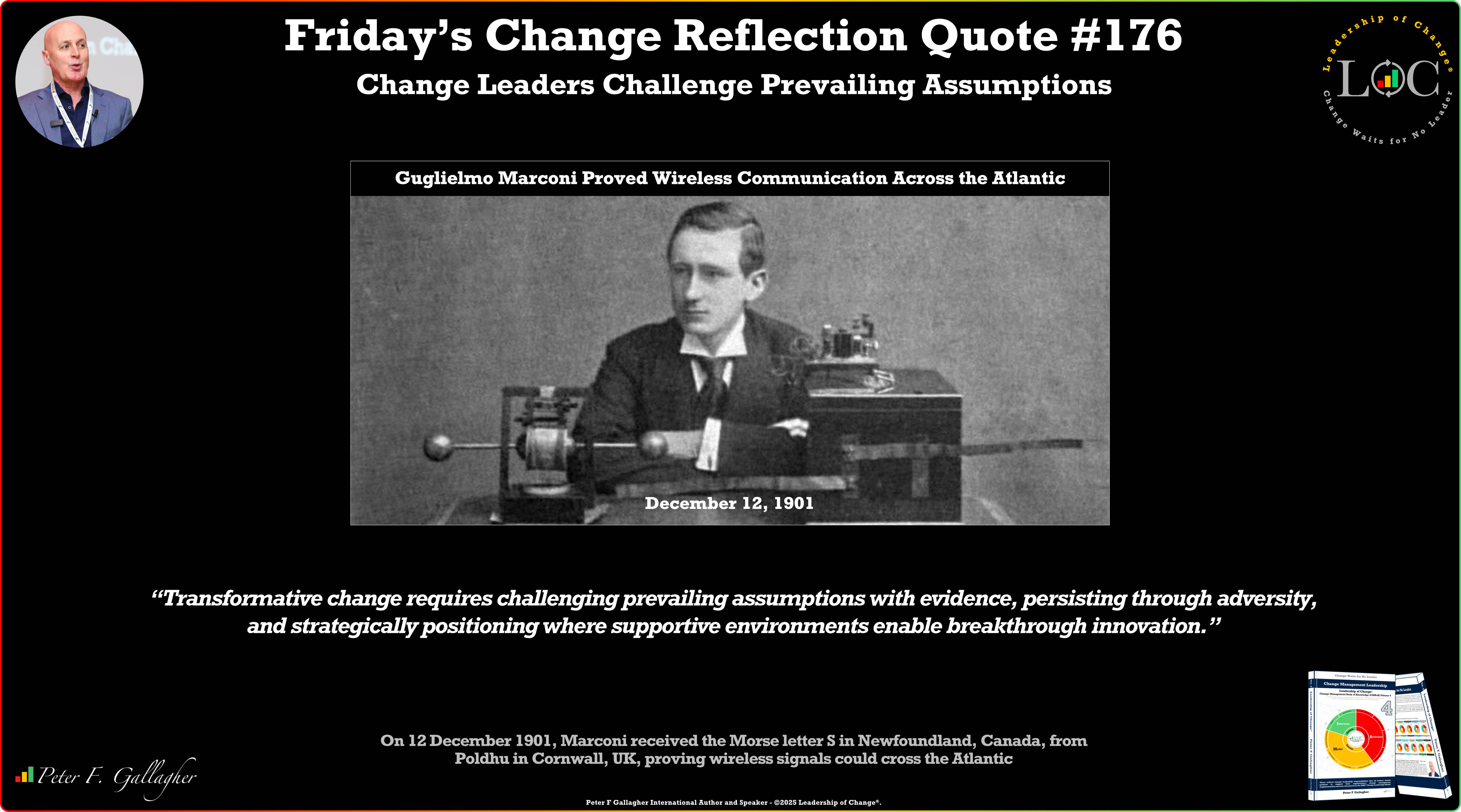Aug01

Leadership Learning!
On this day, 1 August 1975, leaders from 35 nations, including NATO and Warsaw Pact countries, signed the Helsinki Final Act, formalising borders and committing to human rights enforcement. The event took place in Helsinki, Finland, at the conclusion of the Conference on Security and Cooperation in Europe (CSCE). While the Act was not legally binding, it carried significant political weight and laid the foundation for a new form of engagement between adversaries. The Final Act addressed three major areas: security in Europe, cooperation in economics and science, and human rights and fundamental freedoms. One of the most notable outcomes was the mutual acceptance of post-World War II European borders, easing long-standing territorial disputes. The inclusion of human rights, freedom of thought, religion, and movement in the agreement served as a critical platform for later reformist and dissident movements in Eastern Europe. These provisions became tools for internal opposition, notably influencing Charter 77 in Czechoslovakia and Solidarność in Poland, demonstrating how agreements lacking legal enforceability could foster long-term change through civil society movements. They helped establish a standard of accountability on human rights that authoritarian regimes struggled to suppress without international scrutiny. Over time, the Helsinki process evolved into the Organisation for Security and Cooperation in Europe (OSCE), formalised in 1995, which continues to promote dialogue, conflict prevention, and democratic governance throughout the continent. This moment in history reveals the complexities of change through multilateral diplomacy. This illustrates how commitments can sometimes become constraints for those who impose them. Although Soviet leaders expected the security elements to reinforce their power, they underestimated the catalytic potential of the human rights provisions. In contrast, many Western nations embraced the broader, long-term strategy of shaping internal reform through international pressure and persistent engagement. From a leadership perspective, the signing of the Helsinki Final Act exemplifies how change can be initiated even within adversarial and seemingly intractable challenges. It shows that progress is not always driven by force or unilateral action but can emerge through dialogue, negotiation, and shared norms. Leaders at Helsinki did not resolve the ideological divide between East and West, but they did begin a new chapter of influence by introducing principles that could be used to hold systems accountable. This agreement illustrates the enduring value of creating frameworks that outlive political expedience. Although not every participant upheld the commitments made in Helsinki, the legacy of the Final Act is found in the seeds it planted for democratic reform and the peaceful redefinition of European political identity.
Change Leadership Lessons: The diplomatic achievements at Helsinki reveal fundamental principles about effective change leadership in complex, multi-stakeholder environments. Leaders of change must demonstrate strategic patience during complex negotiations, maintaining sustained commitment over extended timeframes to achieve meaningful transformation. They must recognise that agreements designed to maintain stability can inadvertently create powerful catalysts for organisational change throughout their institutions. Change leaders require multi-stakeholder engagement across ideological divides, bringing together diverse perspectives and competing interests to find workable solutions addressing core concerns. They should create permanent institutional frameworks and review mechanisms ensuring that change initiatives continue evolving rather than becoming static agreements. Leaders of change must anticipate that concessions made during negotiations may produce unexpected results,fundamentally altering the original strategic landscape. Change Leaders Model Diplomatic Persistence.
“Change leadership requires strategic patience, embracing paradoxical outcomes whilst engaging diverse stakeholders through institutional frameworks that anticipate unintended consequences.”
Application – Change Leadership Responsibility 1 - Articulate a Change Vision: The Helsinki Final Act demonstrates that articulating a compelling change vision requires diplomatic nuance and an ability to balance short-term concessions with long-term reform. Leaders developed a vision that transcended Cold War rivalries by focusing on shared goals such as peace, cooperation, and respect for human dignity. While the agreement stabilised territorial concerns, it simultaneously embedded human rights principles that would spark future democratic change. Effective change leaders must build visions that address immediate stakeholder concerns while embedding long-term transformation through structured commitments. This requires a leadership approach that unites seemingly opposing interests without compromising the integrity of the change initiative. By framing the vision around mutual security and cooperation, leaders at Helsinki enabled progressive momentum to build within constrained environments. Articulating such a vision means clearly communicating both the practical outcomes and the transformative intent, so that all stakeholders understand its implications and remain engaged throughout the change journey.
Final Thoughts: The Helsinki experience demonstrates how dialogue can plant the seeds of reform even in resistant systems. Lasting change emerges when leaders remain committed to inclusive vision and principled persistence.
Peter F. Gallagher consults, speaks, and writes on Leadership of Change®. He works exclusively with boards, CEOs, and senior leadership teams to prepare and align them to effectively and proactively lead their organisations through change and transformation.
Further Reading: Change Management Leadership - Leadership of Change® Volume 4.
Peter F. Gallagher consults, speaks, and writes on Leadership of Change®. He works exclusively with boards, CEOs, and senior leadership teams to prepare and align them to effectively and proactively lead their organisations through change and transformation.
For insights on navigating organisational change, feel free to reach out at Peter.gallagher@a2B.consulting.
For further reading please visit our websites: https://www.a2b.consulting https://www.peterfgallagher.com Amazon.com: Peter F Gallagher: Books, Biography, Blog, Audiobooks, Kindle
Leadership of Change® Body of Knowledge Volumes: Change Management Body of Knowledge (CMBoK) Books: Volumes 1, 2, 3, 4, 5, 6, 7, 8, 9, 10, A, B, C, D & E available on both Amazon and Google Play:
~ Leadership of Change® Volume 1 - Change Management Fables
~ Leadership of Change® Volume 2 - Change Management Pocket Guide
~ Leadership of Change® Volume 3 - Change Management Handbook
~ Leadership of Change® Volume 4 - Change Management Leadership
~ Leadership of Change® Volume 5 - Change Management Adoption
~ Leadership of Change® Volume 6 - Change Management Behaviour
~ Leadership of Change® Volume 7 - Change Management Sponsorship
~ Leadership of Change® Volume 8 - Change Management Charade
~ Leadership of Change® Volume 9 - Change Management Insanity
~ Leadership of Change® Volume 10 - Change Management Dilenttante
~ Leadership of Change® Volume A - Change Management Gamification - Leadership
~ Leadership of Change® Volume B - Change Management Gamification - Adoption
Keywords: Leadership, Change Management, Business Strategy
 Data Isn’t the Problem. Alignment Is.
Data Isn’t the Problem. Alignment Is. Friday’s Change Reflection Quote - Leadership of Change - Change Leaders Challenge Prevailing Assumptions
Friday’s Change Reflection Quote - Leadership of Change - Change Leaders Challenge Prevailing Assumptions The Corix Partners Friday Reading List - December 12, 2025
The Corix Partners Friday Reading List - December 12, 2025 Measuring the True ROI of Automated Claims Processes: Beyond Speed and Cost
Measuring the True ROI of Automated Claims Processes: Beyond Speed and Cost The New Silicon Frontier: Specialization and the Diverse Landscape of AI Chips
The New Silicon Frontier: Specialization and the Diverse Landscape of AI Chips